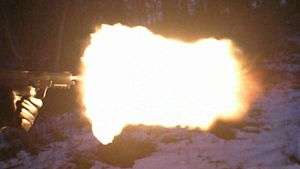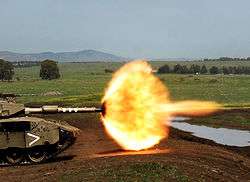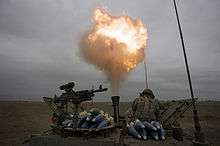Muzzle flash
Muzzle flash is the visible light of a muzzle blast, which is caused by the sudden release and expansion of high-temperature, high-pressure gases from the muzzle of a firearm. The blast and flash are caused by the combustion products of the gunpowder, and any remaining unburned powder, mixing with the ambient air. The size and shape of the muzzle flash is dependent on the combustion energy of propellant being used, the amount of combustible ejecta remaining, and any devices attached to the muzzle (such as a muzzle brake, flash hider or suppressor).



Muzzle blast

The muzzle blast is the explosive shockwave caused by rapid expansion of propellant gases when the pressure seal within the barrel previously maintained by the projectile is suddenly removed as the said projectile leaves the muzzle. The blast is often broken down into two components, an auditory component[1] and a non-auditory component.[2] The auditory component is the sound of the gunshot, and is important because it can cause significant hearing loss to surrounding personnel and also give away the gun's position. The non-auditory component is the infrasonic compression wave, and can cause shock damage to nearby items.
Gun sound
The sound of a gunshot, also known as the muzzle report, may have two sources: the muzzle blast itself, and any shockwave produced by a transonic or supersonic projectile. Suppressors help to reduce the muzzle report of firearms by providing a larger area for the propellant gas to expand, decelerate and cool before release sound energy into the surrounding.[3]
Compression wave
The overpressure wave from a firearm's muzzle blast can contain a significant amount of energy because it travels at an extremely high velocity. Residual pressures at the muzzle can be a significant fraction of the peak bore pressure, especially when short barrels are used. This energy can also be harnessed by a muzzle brake to reduce the recoil of the firearm, or by a muzzle booster to provide energy to cycle the action of self-loading firearms.[4]
Problems caused by muzzle blast
Muzzle blasts can easily exceed sound pressure levels of 140 decibels, which can cause permanent hearing loss even with brief and infrequent exposure.[5] With large guns such as artillery, that danger can extend outwards a significant distance from the muzzle.[6]
The force of the muzzle blast can cause shock damage to items near the muzzle, and with artillery, the energy is sufficiently large to cause severe damage to surrounding structures and vehicles.[7] It furthermore can violently raise dust and debris when firing rifles from prone position and so give away the position. Preventive actions may consist in wetting dry ground or covering the area around the muzzle with a tarpaulin.
Muzzle flash

The muzzle flash refers to the light emitted by the muzzle blast—both visible and infrared—caused by the high heat and pressure.
Muzzle flash characteristics
Muzzle flash can be broken down into five distinct components.[8]
- The muzzle glow is a reddish glow that is visible before the bullet leaves the barrel. It glow is created by superheated gases that have leaked past the projectile and have exited the barrel ahead of it.
- The primary flash is caused by superheated propellant gases exiting the firearm behind the projectile, which radiates its energy to the surroundings partly as visible light. Although amongst the brightest of the flashes, the heat of the primary flash dissipates very quickly, and thus is usually not distinctly noticeable.
- The intermediate flash is caused by shock waves created by the high speeds of the escaping gases and projectile, and appears as a reddish disc shape in front of the muzzle.
- The secondary flash appears farthest from the muzzle as a large white or yellow flame, and is caused by the re-ignition oxidative reaction of incompletely combusted ejecta when mixed with abundant oxygen in the surrounding atmosphere.[9]
- Following the dissipation of the muzzle flash, partially unburnt powder or other heated materials can be further ejected from the muzzle and appear as airborne residual sparks.
Suppression
Muzzle flash, particularly the long duration secondary flash, is an inherent problem in most firearms. Due to its brightness, muzzle flash can temporarily blind the shooter, or give away the shooter's location, especially at night. Ingestion of the muzzle flash from aircraft mounted guns has also been implicated in compressor stall and flameout, causing loss of aircraft.[10]
Flash suppressors attempt to suppress the flash mechanically, by interfering with the shock wave using either a cone or a series of slots at the muzzle of the firearm. However, since the primary cause of the secondary flash is combustion of hydrogen and carbon monoxide, chemical approaches are also used. In World War I, bags of sodium chloride (table salt) were placed in front of the propellant charges of artillery to suppress the flash. Addition of a few percent of alkali salts to the powder for flash suppression is common, typically salts of potassium such as potassium chloride, potassium sulfate, potassium carbonate, and potassium bicarbonate. In both cases, the salts act as catalysts, and interfere with the hydrogen-oxygen combustion to reduce the muzzle flash. The side effects of the alkali salts are a reduction in power, an increase in smoke, and fouling and corrosion of the firearm and nearby equipment (a significant concern with aircraft guns). Ammonium chloride and ammonium nitrate salts have also been tried with success.[10][11]
Detection, with muzzle blast
Gunfire locators detect muzzle blast with microphones and triangulate the location where the shots were fired. They are commercially available, and have been installed in many high-crime areas of large cities. They provide a fairly precise location of the source of a shot fired outdoors—99% to within 33 feet (10 m) or better—and can provide it to police within seconds of a firing.[12]
Muzzle flashes create distinct signatures that can be located using infrared imaging technology.[13] Technology is being developed to detect enemy muzzle flashes before the projectile reaches its target.
References
- Muzzle Blast Sound Intensity, Firearm Sound Pressure Level
- Blast Overpressure Studies. Nonauditory Damage Risk Assessment for Simulated Muzzle Blast from a l2Omm Ml2l Mortar System. (abstract)
- "Definition for "sound suppressor"". MidwayUSA.
- "Definition for "compensator"". MidwayUSA.
- Hearing protection FAQ Archived 2007-06-28 at the Wayback Machine
- Prediction of Standoff Distances to Prevent Loss of Hearing from Muzzle Blast
- Muzzle Blast Damage to Combat Vehicles (abstract)
- Tony DiGiulian, Muzzle flash, 14 August 2006
- G. Klingenberg, Gun Muzzle Blast and Flash, 21 July 1988
- WO application 1986/001796A1, Winkler, David Allen, "Gun Flash Suppressants", published 1986-09-24
- Rudolf Meyer, Josef Köhler, Axel Homburg (2007). Explosives, 6th Ed. Josef Köhler (trans.). Wiley-VCH. p. 218. ISBN 978-3-527-31656-4.CS1 maint: uses authors parameter (link) CS1 maint: others (link)
- "Random Gunfire Problems and Gunshot Detection Systems" (PDF). U.S. Department of Justice. December 1999.
- Infrared sniper detection enhancement
External links
- High-speed photographs of shotgun muzzle blasts
- Tutorial on how to add muzzle flares to a gun